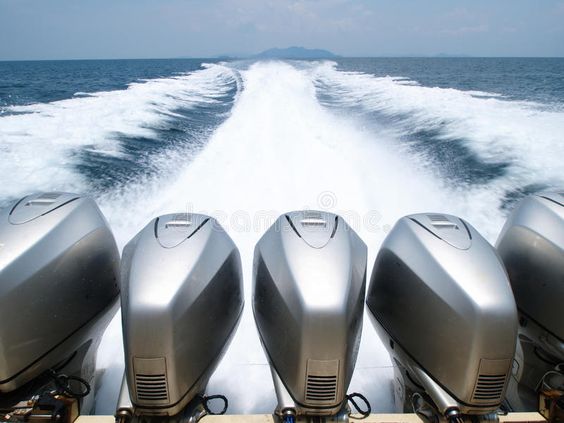With so many different boat engines on the market, it’s hard to figure out which one suits you best. Every boat engine or motor is designed with a specific purpose in mind, each with its own advantages and disadvantages. For the best experience, you must choose an engine that meets your needs perfectly.
This guide offers a quick overview of the different types of boat engines. Keep these important details in mind when you’re out shopping for an engine for your boat.
Outboard engines
Best for: Small boats, fishing vessels
Pros: Easy to maintain, cost-effective
Cons: Some models can be loud, not very powerful
An outboard engine is a self-contained motor that includes a propeller and gearbox. It’s installed on the transom of the boat or outside the hull hence the name outboard. This type of motor propels the boat forward and serves as a steerer to control the vessel’s direction of movement.
Outboard engines are great for small vessels like fishing boats because they are light and powerful. Newer outboard motor models are not as loud as older ones, so you don’t have to worry about scaring the fish with your engine.
A lot of boaters opt for an outboard engine because they’re so easy to maintain. Since the outboard motor is self-contained, it’s easier to clean compared to other types of boat engines. You can also tilt the outboard conveniently depending on the depth of the water to avoid damaging it.
Outboard engines provide more transom access, making them ideal for fishing boats. However, having this type of boat engine means you will not have a full swim platform.
Inboard engines
Best for: Water sports
Pros: Powerful, more space in the boat
Cons: Harder to maintain or repair
Inboard engines are found inside the boat’s hull; the opposite of an outboard engine. This type of motor is best for boats used for water sports with its high torque and horsepower. Inboard engines can be diesel or gasoline-powered. Diesel inboard engines are typically used by larger boats.
An inboard engine is connected to a drive shaft, which is angled down towards the water where the propeller is attached. Behind the propeller is a rudder for steering. This engine is considerably heavier than outboard motors.
Because inboard engines are inside the hull, it’s much safer for water skiers and wakeboarders. There’s no danger of anyone hitting the propeller when they get too close to the boat. An inboard engine can also make consistent track for the skiers or wakeboarders.
A downside of inboard engines is less convenience in accessing the motor for maintenance and repair. Since it’s cramped in a compartment inside the hull, reaching the engine is harder compared to outboard engines.
The two types of inboard motors are the straight shaft inboard and the V-drive inboard. The straight shaft inboard engine is the most common. It’s installed in the hull’s middle, facing the rear end of the boat. The V-drive inboard is installed at the back end facing forward. This type of propulsion system allows more cabin space and additional seating.

Stern drive engines
Best for: Shallow waters
Pros: Better toque, more manoeuvrability, fuel-efficient
Cons: More expensive, complex maintenance
Also known as inboard/outboard (I/O), a sterndrive engine is a combination of outboard and inboard engines. These motors are typically quieter and more fuel-efficient. A stern drive engine is placed under the transom just like an inboard engine, while the drive unit is under the swim platform as with an outboard engine.
A sterndrive engine is best for shallow waters because there is no gear under the boat. But just like with outboard engines, the exposed portions of the drive system are more prone to damage and rusting.
The hull compartment is also at risk of fire from the trapped gas vapour. If your boat has a sterndrive, it’s important to use a blower on the engine to prevent this accident from happening.
Jet boat engines
Best for: Personal watercrafts
Pros: High performance
Cons: High cost, loud
A jet drive propulsion system is often associated with personal watercraft (PWC) like Jet Ski and Waverunner but it’s also installed on several modern boats. The jet drive itself is placed inside the engine’s housing called the impeller. Water is pulled by the drive system from under the impeller then is forced towards the rear, creating thrust to move the boat.
A jet drive system requires neither a propeller blade nor a large space to house it. This means more room for boat builders to work on and include additional boat features. This type of boat propulsion system is very attractive to boaters who like high-performance vessels. Higher fuel consumption and loud noise are expected trade offs for agility in the waters.
Tips to find the right boat engine
Now that you know the basics of boat engines, it’s time to find the ideal one for you. Here are some things to keep in mind when you’re searching for the best engine for your boat:
-
Find the right size. You need to find an engine that fits your boat exactly. An engine that’s too big or too small will impact your boating experience. And it could make boating that much harder.
-
Know how much power you need. This depends heavily on how you’re using the boat. If you’re using your boat for water sports, for example, you’ll need an engine with a lot of horsepower and agility. If you’re just cruising, something with not too much horsepower would be best.
-
Think about fuel efficiency. When shopping around, carefully look at the manufacturer ratings to see if the engine is fuel efficient. Not all high-powered engines consume a lot of petrol and vice versa.
-
Figure out your budget. Finally, think about your budget. How much can you comfortably afford, and will it be enough to buy the perfect boat engine? Look at your options and see if a boat engine loan is more advantageous.
Apply for a boat loan at Aussie Boat Loans
Whichever type of boat and boat engine you choose, Aussie Boat Loans can help you finance your purchase. Call Aussie Boat Loans now at 1300 889 669 or inquire online to get more information on our boat loan products. Start your loan application today and ride your new boat sooner!
FAQ
The four types of boat engines are the outboard engine, inboard engine, stern drive engine, and the jet boat engine. Each has its own pros and cons. Finding the right one depends on what you use your boat for.
What type of boat engine is best?
It depends on what you want out of your boating experience. For fishing, the outboard engine is usually best because it’s more cost-effective and easier to maintain. It can also go into deeper water compared to stern drive engines. Meanwhile, if you’re into water sports, an inboard motor is probably best because it’s more powerful.
Do boats have V8 engines?
Some boats have V8 engines, but it depends on the manufacturer. Recently, Honda released a V8 outboard engine for its boats named the BF350.
How many types of outboard motors are there?
Outboard motors come in two-stroke and four-stroke engines. Two-stroke outboard engines are simpler and have quicker response times. Meanwhile, a four-stroke outboard engine is better suited for cruising.
What type of engine is good for a small boat?
For smaller boats, outboard engines are usually ideal because they’re lighter but still powerful.
What is the most efficient type of boat engine?
Some say that the outboard engine is the most efficient as it is lighter, more powerful, and more cost-effective. However, it all depends on what you want from your engine and what you use the boat for.
What is a four-stroke boat engine?
A four-stroke boat engine is a type of engine that requires four movements to complete a cycle. Usually, four-stroke engines are cheaper to maintain, more fuel-efficient, and more environmentally friendly.
What is the difference between an inboard and an outboard motor?
The main difference between an inboard and an outboard motor is where it’s mounted. Inboard motors can be found inside the hull of the boat. Meanwhile, an outboard motor is found attached outside the boat.




